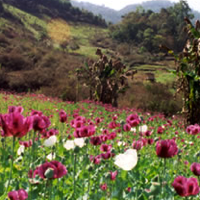From the early 1950s until 1990, when Afghanistan’s opium production surpassed that of Myanmar, most of the world’s illicit opium originated in mainland Southeast Asia. This is partly because the region’s rugged hills and mountains, heavy monsoon rains and lack of transport infrastructure have long protected rebel armies and illegal opium poppy cultivation from the writ of central governments and anti-drug agencies. Myanmar’s turbulent political history and internal wars since its independence in 1948 also contributed significantly to Asia’s long reign as the global leader in illicit opium production, as the opium economy and the war economy clearly nurtured one another.
After decades of expansion in Southeast Asia, illegal opium poppy cultivation eventually receded (.pdf) during the early 2000s, from an estimated total of 390,000 acres across the region in 1998 to just 60,000 acres in 2006. In that time, cultivation almost completely disappeared in Thailand (with an all-time low of 388 acres cultivated in 2006) and seriously decreased in Laos (an all-time low of 3,950 acres in 2007) and Myanmar (an all-time low of 53,100 acres in 2006). However, poppy cultivation in Southeast Asia subsequently rebounded between 2006 and 2010, increasing by 70 percent to an estimated 102,000 acres today. A number of factors explain the regional production rebound, including uncompensated opium suppression, rising opium prices, more favorable weather and resurgent conflicts in Myanmar. As a result, Myanmar remains the world’s second-largest illicit opium producer, with most of its poppy cultivation taking place in Kachin and Shan states in the north and northeast of the country, along the borders with China, Laos and Thailand.
Clearly, counternarcotics efforts have failed to suppress or permanently reduce both illicit opium production and, as a consequence, heroin trafficking in Southeast Asia. The explanation lies in the fact that regional counternarcotics efforts have emphasized measures targeting drug supply and trafficking -- measures that have proven ineffective if not counterproductive.

